WD-40 will also remove hard water stains from a toilet. To remove hard water stains from a toilet using WD-40, spray it all over the bowl then wait for 15 minutes before scrubbing with a brush. Instead of flush the WD-40, wipe the toilet bowl using a rag or toilet paper.
I often have people ask me if they can use Coke to remove stains from their toilets. After all Coke has so many uses outside the dining table.
Coke does and will remove hard water stains from your toilet bowl. It is however not the best option and will not remove stubborn stains. A baking soda or borax and vinegar solution is the most effective way to get rid of hard water stains from toilets. They are cheap too.
The most important thing is to make sure that you do not scratch your toilet bowl whatever method you choose for hard water stain removal. You should also as much as possible avoid using chemicals like acids or bleach.
To prevent hard water stains from forming/recurring in a toilet, consider installing a water softener. The water softener removes the hard water minerals before the water enters your house through an ion exchange process therefore ensuring that stains will not form on porcelain surfaces.
MATERIALS NEEDED
- Vinegar
- Baking soda
- Borax (optional)
- Pumice stone
- Rubber gloves
- Toilet brush
1. HOW TO REMOVE HARD WATER STAINS FROM A TOILET USING VINEGAR
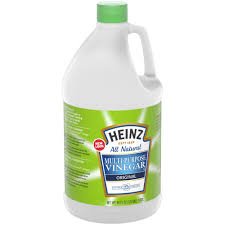
- Remove the water at the bottom of the toilet bowl. Scoop it out with a cup or soak it with a sponge.
- Pour the vinegar inside the toilet bowl slowly until it reaches the waterline.
Note: It is impossible to fill the bowl with vinegar since it will flow down the drainpipe. The reason for removing the water at the bottom of the toilet is to allow vinegar to access the toilet trap which is also more susceptible to staining. To make sure the vinegar gets into the other parts of the bowl, swish it around with a toilet brush after every 10 minutes.
- Swish the vinegar around the toilet bowl with the toilet brush often to keep the toilet bowl moist. Do this for about 30 minutes.
- Flush the toilet.
- Use a detergent and a toilet brush to thoroughly scrub the toilet not forgetting the toilet rim.
- To clean the toilet trap opening where a toilet brush cannot access, use a toothbrush to scrub until all stains are removed.
This is not magic however. Unlike what you might have read or heard elsewhere, you might need to do this a few times before all the stains are gone.
2. HOW TO REMOVE HARD WATER TOILET STAINS USING VINEGAR AND BAKING SODA
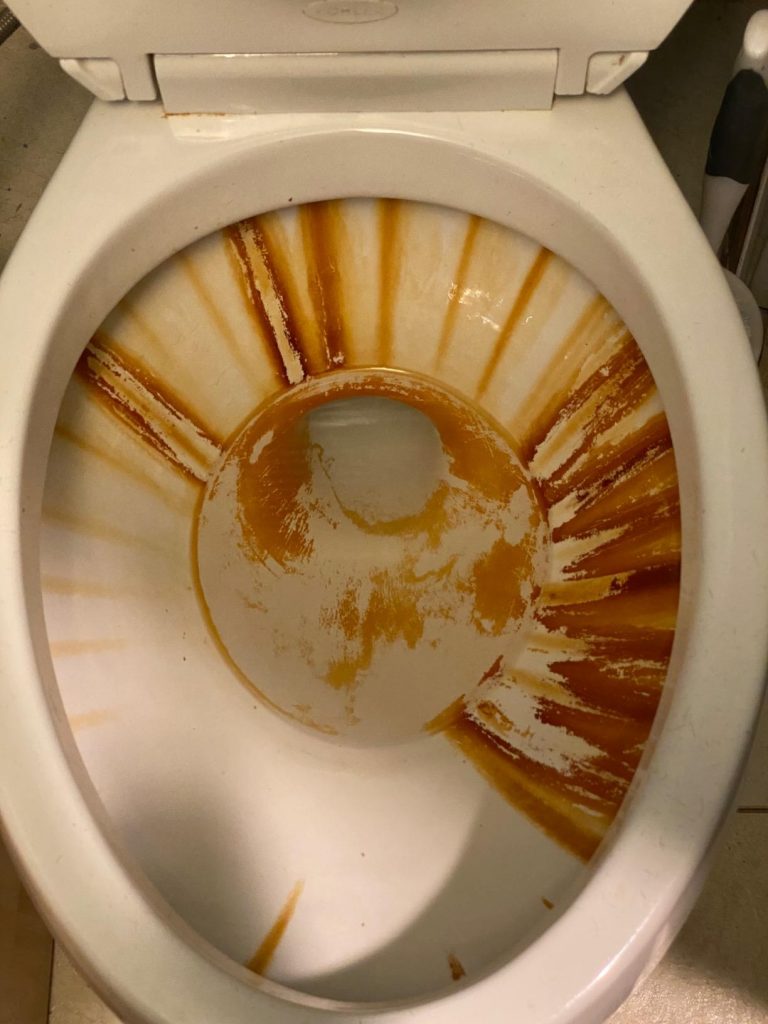
Vinegar is an acidic substance while baking soda is a mild alkaline substance. This 2 are the most widely used home cleaning agents and they are very effective. When they are mixed together, a fizzing reaction will occur and that is why it is always important to mix them slowly.
- Using a cup or a sponge, remove the water at the bottom of the toilet.
- Pour 1 cup of vinegar inside the toilet bowl and let it sit for 5 minutes
- Slowly add a generous amount of baking soda inside the bowl followed by another cup of vinegar.
- Swish the mixture around the toilet bowl and rim with a toilet brush after every 5 minutes for 30 minutes.
- After the one hour mark scrub the toilet bowl with the toilet brush targeting any visible stain.
- Flush the toilet and confirm all stains are gone.
- If there are some stains at the toilet trap opening where the toilet brush can’t get to, use a toothbrush to scrub them away.
3. HOW TO REMOVE TOILET HARD WATER STAINS USING VINEGAR AND BORAX
Borax is an alkaline cleaning agent which is stronger than baking soda. It can be legally used in the United States but it is banned in most countries like the UK and the European Union.
Why is borax banned in those countries? The explanation given for it is that it has a high likelihood of causing skin irritation. It was therefore added in the European Chemicals Agency’s “list of substances of very high concern”. Instead of borax they now use a borax substitute
United States has not found any substantive cause for banning borax as a cleaning agent. If handled properly, it is a wonderful and strong cleaning agent. Here is how to remove stubborn toilet stains using borax and vinegar.
- Use a cup or a sponge to remove the water at the bottom of the toilet.
- Pour a ½ cup of vinegar in the toilet bowl, swish it around with a brush and wait for a minute.
- Add one cup of borax spreading it slowly on the bowl.
- Slowly add 2 cups of vinegar and let the solution fizzle.
- Swish the solution round the toilet bowl after every 10 minutes for 30 minutes.
- Scrub the bowl with a toilet brush not forgetting the rim of the toilet.
- Flush the toilet to confirm all stains are gone.
- Use a tooth brush to remove the stains at the bottom of the toilet where the toilet brush cannot reach.
HOW TO GET RID OF HARD WATER STAINS IN TOILET RIM HOLES
If you hold a small mirror against the rim of your toilet, you will see small holes through which flush water comes out to rinse the bowl. If you live in area with hard water and especially calcium, the scum will accumulate in the toilet rim blocking this holes. The end result is that your toilet’s flushing power will be greatly compromised.
This is how to remove hard water stains that block your toilet rim holes:
- Heat up vinegar until it starts boiling.
- Remove the toilet tank lid and place it away in a safe place.
- Pour the hot vinegar through the overflow tube slowly and let it sit for some time.
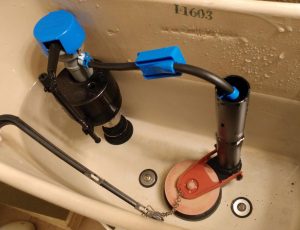
Note: The overflow tube is the large tube at the middle of the toilet tank. It channels excess water in the toilet tank back to the toilet bowl to prevent overflowing.
- After a while, use a small L-shaped Allen key to manually unblock the toilet rim holes.
- Flush the toilet to wash down all the scum.
I have written a separate post on this problem. Read it here.
HOW TO GET RID OF HARD WATER STAINS FROM A TOILET TANK
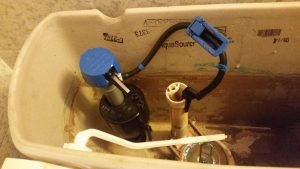
Toilet tanks are made from the same material as the toilet bowl. They are therefore also prone to staining but most people ignore them since they are not conspicuous like toilet bowls.
Ignoring your toilet tank stains is however not a nice move since eventually it will affect your toilet’s flushing power.
This is how to clean a toilet tank that has been invaded by stains.
- Turn off the water supply to the toilet. Locate the shut off valve on the toilet’s rear wall and turn it clockwise.
- Flush the toilet holding the flushing handle down to remove as much water as possible.
- Remove the toilet tank lid
- Use a sponge to remove the water left at the bottom of the toilet.
- Fill the toilet tank with vinegar up to just below the overflow tube.
- Put the toilet tank lid back on.
- Leave the vinegar to stay in the tank overnight.
- In the morning flush down the toilet.
- Remove the lid and place it in a safe place
- Sprinkle a detergent all over the tank and leave it for 15 minutes
- Scrub the tank with a brush with firm bristles targeting all the stains.
- In areas where you can reach with a normal brush use a toilet brush until all stains are all removed.
- Turn on the toilet water supply and flush the toilet to inspect if all stains have been removed.
- Cover the tank with the lid.
It is not advisable to use bleach or toilet tank tablets that are corrosive. These substances cause the rubber parts of a toilet tank like toilet flappers and fill valves to wear out.
HOW TO REMOVE HARD WATER STAINS IN A TOILET WITH A PUMICE STONE

A toilet ring is a brown discoloration that occurs around the toilet bowl waterline as a result of hard water. The mineral elements present in the water like iron react with oxygen to form iron oxide which forms around the toilet waterline.
Toilet rings tend to recur even after removing them since the problem is the water and not your cleaning ability. These toilet ring stains are more stubborn than other stains and therefore removing them is a little harder than other stains.
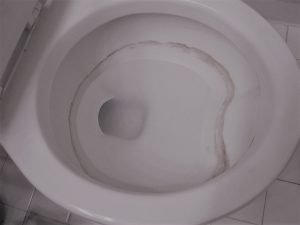
- Put the pumice stone in water for 15 minutes in order for it to soften.
- Once the pumice stone is soft enough, pick one spot and start rubbing the stains off starting initially slowly to avoid scratching the porcelain.
- Work your way round the ring until you have all it.
- Flush the toilet to wash away the scum.
HOW TO PREVENT HARD WATER STAINS IN A TOILET
Hard water stains do not form in a toilet overnight. The accumulation of this stains happen over a period of time and you can therefore prevent it before it becomes an eyesore.
Regularly cleaning your toilet with vinegar (say once a week) is a great way to prevent the toilet bowl from getting those stubborn stains. Pouring a vinegar in your toilet tank and leaving it overnight is also a great way to put the stains at bay.
DOES COKE REMOVE HARD WATER STAINS IN TOILETS?
Coke contains an acid that will eat away the stains from your toilet. Remove the water at the bottom of the toilet and pour about a liter of coke and let it stay overnight.
Although coke has been used effectively to remove hard water toilet stains, if you need to remove stubborn stains then your best bet would be a vinegar and baking soda solution.
CONCLUSION
Hard water toilet stains can be disgusting and unpleasant to look at. It is unfortunate that there is no a definite way to remove them forever. As long as hard water keeps flowing in your toilet you will always have to deal with them.
Thoroughly cleaning your toilet often with vinegar, baking soda and borax or borax substitutes is a sure way of preventing the hard water stains from forming on your toilet bowl. It is always easier to prevent them than to clean them.

